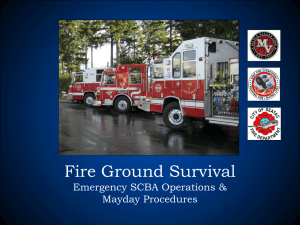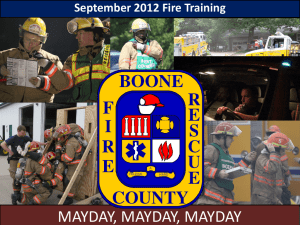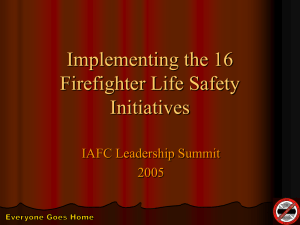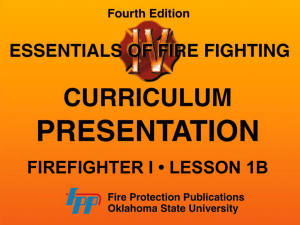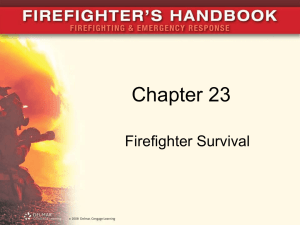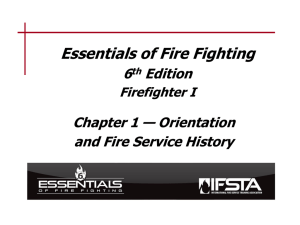WARREN COUNTY FIRE CHIEFS ASSOCIATION Subject
advertisement
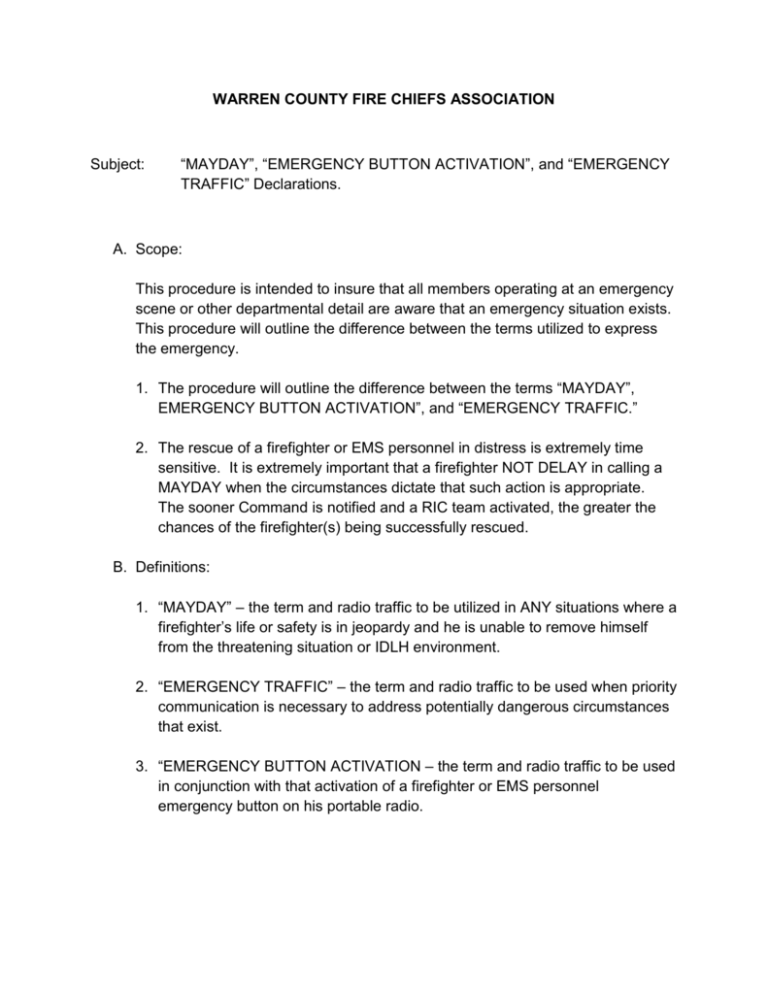
WARREN COUNTY FIRE CHIEFS ASSOCIATION Subject: “MAYDAY”, “EMERGENCY BUTTON ACTIVATION”, and “EMERGENCY TRAFFIC” Declarations. A. Scope: This procedure is intended to insure that all members operating at an emergency scene or other departmental detail are aware that an emergency situation exists. This procedure will outline the difference between the terms utilized to express the emergency. 1. The procedure will outline the difference between the terms “MAYDAY”, EMERGENCY BUTTON ACTIVATION”, and “EMERGENCY TRAFFIC.” 2. The rescue of a firefighter or EMS personnel in distress is extremely time sensitive. It is extremely important that a firefighter NOT DELAY in calling a MAYDAY when the circumstances dictate that such action is appropriate. The sooner Command is notified and a RIC team activated, the greater the chances of the firefighter(s) being successfully rescued. B. Definitions: 1. “MAYDAY” – the term and radio traffic to be utilized in ANY situations where a firefighter’s life or safety is in jeopardy and he is unable to remove himself from the threatening situation or IDLH environment. 2. “EMERGENCY TRAFFIC” – the term and radio traffic to be used when priority communication is necessary to address potentially dangerous circumstances that exist. 3. “EMERGENCY BUTTON ACTIVATION – the term and radio traffic to be used in conjunction with that activation of a firefighter or EMS personnel emergency button on his portable radio. 4. “EMERGENCY EVACUATION SIGNAL” – the audible signal used on the fireground to alert personnel present of the need/order to evacuate the structure and regroup outside for safety and accountability purposes. The signal is: One (1) thirty second long air horn blast accompanied by the EMERGENCY ALERT TONE (Alert 2 Tone) and radio announcement by the dispatcher on assigned TAC Channel for the incident. 5. “EMERGENCY ALERT TONE” – an audible tone of consistent frequency and duration intended to draw attention to radio traffic. This tone is generated by the dispatcher and is called the ALERT 2 TONE by the Warren County Communications Center. 6. “EMERGENCY EVACUATION” – an order given to cause the immediate evacuation of a structure, portion of a structure, or geographical area as identified by Command. C. Situations involved in this procedure. The following situations dictate the use of the MAYDAY, EMERGENCY TRAFFIC, EMERGENCY BUTTON ACTIVATION, EMERGENCY EVACUATION, and ALERT TONE: 1. “MAYDAY” – to be used in ANY situation where a firefighter’s life or safety is in jeopardy and is unable to remove him/herself from the threatening situation or IDLH environment. A firefighter MUST DECLARE A “MAYDAY” when confronted by, but not limited to, the following situations: a. Immediately believing the firefighter is disoriented or lost and unable to exit any existing IDLH environment. b. Immediately upon the sounding or detection of a firefighter’s low air alarm and a firefighter not being able to promptly exit any existing IDLH environment. c. Immediately upon a firefighter becoming trapped or entangled to the point of requiring assistance. d. Immediately upon a firefighter sustaining ANY injury which impairs his ability to exit any existing IDLH environment. e. Immediately upon discovery of a vital PPE problem which poses a substantial threat of harm with the firefighter unable to immediately exit the IDLH environment. f. Immediately upon a firefighter becoming lost or missing from their crew. g. Immediately upon discovery of another firefighter experiencing any of the above situations. 2. “EMERGENCY TRAFFIC” – to be used when a priority communication is necessary to address a potentially dangerous circumstance: a. Any imminent potential for or an actual structural failure. b. Rapidly changing fire conditions. c. Water supply interruption. d. Any circumstance that poses a material risk to firefighter safety. e. Immediate evacuation of the building is necessary for any circumstance the Incident Commander deems necessary. f. Any non-fire related incident where information must be transmitted immediately for the safety of those operating at the incident. All personnel operating at the emergency scene (or on the same radio talk group) shall refrain from transmitting any non-critical message upon hearing the “EMERGENCY TRAFFIC” transmission and remain alert for all radio transmissions from the Incident Commander until such time that the “resume normal radio traffic” directive is issued by Command. 3. EMERGENCY EVACUATION SIGNAL – The Incident Commander will activate the Emergency Evacuation Signal any time a fireground situation exists that warrants the regrouping of all personnel to their apparatus or a staging area for purposes of safety and accountability. A PAR will be taken immediately following an emergency evacuation. The EMERGENCY EVACUATION SIGNAL shall be: One (1) thirty second long air horn blast accompanied by the EMERGENCY ALERT TONE (Alert 2 Tone) and radio announcement by the dispatcher on assigned TAC Channel for the incident. 4. EMERGENCY ALERT TONE – during any situation on the fireground for which a MAYDAY has been declared, an EMERGENCY EVACUATION has been ordered, or at times as otherwise requested by the Incident Commander, the dispatcher shall broadcast the “EMERGENCY ALERT TONE” and echo the MAYDAY, EMERGENCY EVACUATION, or other command from the Incident Commander to further insure that all those operating on the radio talk groups are aware of the need for the actions outlined in these procedures. 5. EMERGENCY BUTTON ACTIVATION – the activation of firefighter or EMS providers Emergency Button to indicate that the firefighter or EMS provider is declaring that they are experiencing an EMERGENCY and need immediate assistance. The EMERGENCY BUTTON ACTIVATION may occur in tandem with a MAYDAY on a fire scene or may occur on an EMS, Inspection, Investigation, or other detail where the crew or crewmember has become endangered and needs immediate assistance. This may be the only indication that an individual is in trouble. D. Fire Ground MAYDAY Procedure The following procedure will be used to alert firefighters on the emergency scene of a MAYDAY. 1. To clear all radio traffic on the fire ground talk group (TAC Channel) the firefighter requesting the MAYDAY shall precede the message by repeating the word “MAYDAY” three (3) times followed by “FIREFIGHTER DOWN” Example: “MAYDAY, MAYDAY, MAYDAY, FIREFIGHTER DOWN.” 2. The firefighter shall follow the initial MAYDAY call with information indicating: a. The nature of the MAYDAY b. The location of the firefighter c. Company identification d. Firefighter identification by name(s) e. Number of firefighters involved f. What, if any, plans they have to remove themselves from the situation. Example: “MAYDAY, MAYDAY, MAYDAY, FIREFIGHTER DOWN, Second Floor, Firefighter Doe from Engine 15. 3. Any fire company finding a firefighter down shall declare a MAYDAY and the MAYDAY information shall be repeated including the manner of removal from the structure. Example: “MAYDAY, MAYDAY, MAYDAY, FIREFIGHTER DOWN, Lieutenant Doe from Engine 15, We will be coming out the Side C door, first floor.” 4. At the time of the MAYDAY, the Incident Commander will direct all companies to switch the Mayday 1 or Mayday 2 Talkgroup for continuation of routine fireground communications. The original fireground talkgroup (TAC Channel) will only be used for the MAYDAY and (RIC) Rapid Intervention Crew(s), and the RIC Group Supervisor. 5. Incident Command will assure that all operating companies have switched to the Mayday Talkgroup. This shall be accomplished by conducting a PAR. 6. Command will request that the Warren County Communication Center assign a dispatcher to the talk group which the MAYDAY originated. 7. In cases of a MAYDAY transmission, an extra alarm assignment will be automatically dispatched by the dispatcher and the extra alarm companies assigned to staging unless another assignment is given by the incident commander. 8. After the MAYDAY is cleared, the Incident Commander will decide how talk group (TAC Channel) reassignments will be handled with the Communications Center. E. Fire Ground Emergency Traffic Procedure The following procedure will be used to clear radio traffic for priority communication when necessary to address potentially dangerous circumstances. 1. To clear all traffic on the fire ground talk group, the firefighter requesting exclusive use of the talk group shall announce his/her radio ID or assignment ID (i.e. vent group, search, etc) and declare “EMERGENCY TRAFFIC”. At this time no other radio traffic shall be transmitted until the nature, location, and type of emergency is identified. The “EMERGENCY TRAFFIC” declaration shall be reserved for situations on the fire ground presenting imminent danger to firefighters. (e.g. potential building collapse energized electrical wires posing electrocution hazard, loss of water supply with firefighters inside a structure, etc.) The Incident Commander, upon hearing the EMERGENCY TRAFFIC declaration, shall immediately repeat the EMERGENCY TRAFFIC as well as the issuance of orders to rectify or retreat from the situation. The Incident Commander upon hearing the Emergency Traffic Declaration shall immediately request the EMERGENCY ALERT TONE (Alert 2 Tone) and repeat the emergency traffic as well as orders to rectify or retreat from the situation. Example – ALERT TONE “EMERGENCY, EMERGENCY, EMERGENCY - All Companies operating at 12345 Main Street, retreat! 2. If the building is to be evacuated, Incident Command shall authorize the activation of the Emergency Evacuation Signal. “Which is followed by the radio talk group announcement to “Evacuate.” 3. Subsequent to evacuation, a PAR is to be immediately taken and appropriate action taken based on the result. Note: The MAYDAY declaration is reserved for only those situations when a firefighter is or is believed to be in peril as described above. When a hazardous condition exists, the “EMERGENCY TRAFFIC” declaration shall be utilized. F. Emergency Button Activation 1. Emergency Button Activation will cause the portable radio to automatically switch to the Fire Hailing Talk Group if the radio is not operating on a TAC channel. If the radio is operating on a TAC channel it will remain locked on that TAC channel. 2. Warren County Communications shall immediately attempt to contact the affected portable and follow established WCCC policies for Emergency Button Activation (Appendix A), when the radio reverts to Fire Hailing. 3. When an Emergency Button is activated on the scene of working incident, Warren County Communications Center will advise Command of the Emergency Button Activation if the established clearing policy in not followed. 4. Command will attempt to contact the crew/crewmember who has activated the Emergency Button. This communication will take place on the affected TAC channel. 5. If no contact is made with Command, a MAYDAY will be declared and RIC will be activated in accordance with the RIC Policy. 6. In the case where RIC has been deployed after an EMERGENCY BUTTON ACTIVATION, the RIC Team(s) and RIC Group Supervisor will remain on the assigned TAC and all emergency scene operations will switch to the Mayday Talk Group. 7. Mayday 1 will be utilized for Tac 2 – Tac 11 and Mayday 2 will be utilized for Tac 12 – Tac 21. Adopted: 08/05/2010 Revised: 07/05/2012

